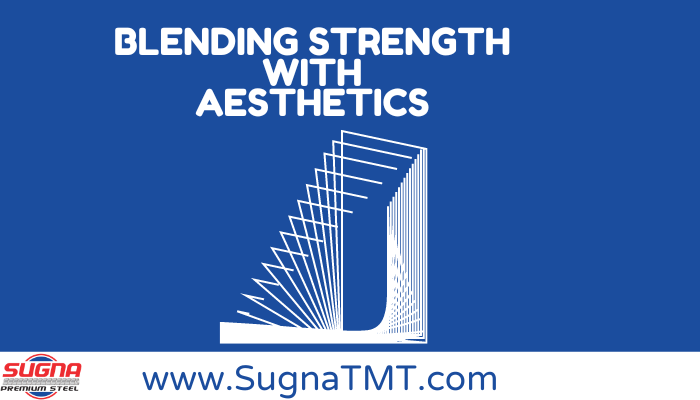In the dynamic world of construction, the marriage of strength and aesthetics has always been a paramount consideration. One material that has significantly contributed to this synergy is Thermo-Mechanically Treated (TMT) Bars. As architects and builders seek innovative solutions, TMT Bars have emerged as a game-changer, providing a perfect blend of robust structural support and aesthetic flexibility.

The Evolution of TMT Bars
With roots tracing back to the mid-20th century, TMT Bars have evolved from conventional steel reinforcement. The thermo-mechanical treatment process imparts unique properties, enhancing their strength and durability. The shift from traditional bars to TMT Bars was driven by the need for a material capable of withstanding diverse environmental challenges.
Strength and Durability
TMT Bars boast a distinctive composition, including a careful balance of elements that contribute to their exceptional strength. Their resistance to corrosion and rust ensures longevity, making them a preferred choice in regions prone to adverse weather conditions. This robust nature not only enhances the lifespan of structures but also reduces maintenance costs significantly.
TMT Bars in Modern Construction
Architects today leverage the structural benefits of TMT Bars to design and construct awe-inspiring buildings. The flexibility and strength of these bars make them particularly suitable for use in high-rise structures, where the demand for stability and safety is paramount. The ability to withstand intense loads while maintaining structural integrity positions TMT Bars as an indispensable component in contemporary construction.
Architectural Design Trends
In the realm of architectural design, TMT Bars have become more than just structural elements – they are now integral to the artistic vision. Architects are creatively integrating TMT Bars into their designs, using them not only for support but also as design features. The result is structures that not only stand tall but also captivate with their aesthetic appeal.
Case Studies
Several iconic structures around the globe stand as testaments to the impact of TMT Bars on architectural design. From skyscrapers to bridges, these structures showcase the seamless integration of strength and aesthetics. Case studies of such projects shed light on the transformative role that TMT Bars play in shaping the architectural landscape.
Challenges and Solutions
Despite the many advantages, architects and builders face challenges when working with TMT Bars. Issues such as welding difficulties and specific construction requirements can arise. However, the industry has responded with innovative solutions, pushing the boundaries of what is achievable in architectural design.
Sustainability Aspect
In an era where sustainability is a top priority, TMT Bars contribute positively to the environment. Their durability reduces the need for frequent replacements, minimizing construction-related waste. Additionally, the production process has become more eco-friendly, aligning with the global push towards sustainable construction practices.
Cost-Effectiveness
Contrary to common misconceptions, using TMT Bars can be economically advantageous in the long run. The initial investment may be slightly higher, but the durability and reduced maintenance costs make TMT Bars a cost-effective choice over the life of a structure. This economic benefit has contributed to the widespread adoption of TMT Bars in construction projects.
Regulatory Standards
Ensuring compliance with regulatory standards is crucial in construction. TMT Bars, being a vital structural component, must adhere to stringent safety measures. Architects and builders must prioritize compliance to guarantee the structural integrity and safety of the constructed edifice.
Tips for Architects and Builders
For architects and builders looking to maximize the benefits of TMT Bars, collaboration is key. Working closely with structural engineers ensures that the design not only meets aesthetic goals but also adheres to safety and stability requirements. Integrating TMT Bars seamlessly into the overall vision requires a coordinated effort from the entire design and construction team.
Future of TMT Bars in Architecture
As technology continues to advance, the future of TMT Bars in architecture looks promising. Ongoing research aims to further enhance their properties, opening up new possibilities in design and construction. Architects can look forward to more versatile and sustainable solutions as the industry evolves.
Conclusion
In conclusion, the integration of TMT Bars in architectural design represents a harmonious balance between strength and aesthetics. From their evolution to the current trends and future possibilities, TMT Bars have proven to be a cornerstone in modern construction. Architects and builders now have a versatile tool that not only reinforces structures but also elevates them artistically.

